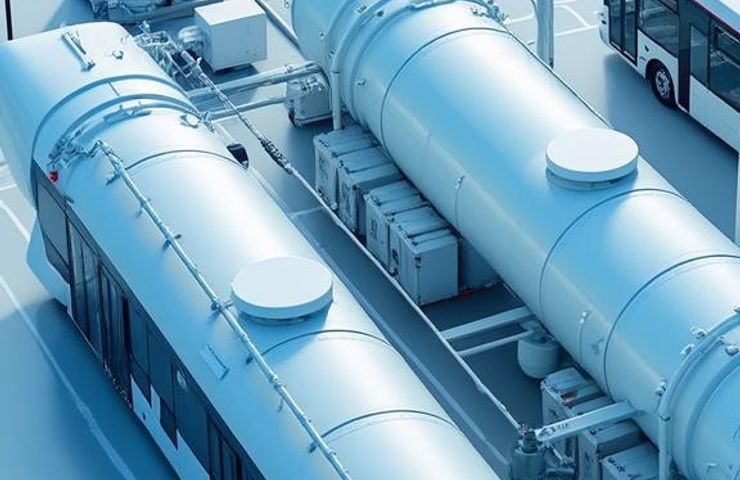
Hydrogen Storage Market in 2025: Composite Tank Leaders Push for Global Decarbonization
August 1, 2025High-pressure hydrogen storage has quietly stepped out of the shadows and into the spotlight, becoming a linchpin in the push for clean energy. Fast forward to 2025, and with the world demanding more zero-emission mobility and deeper industrial decarbonization, three industry players—Hexagon Purus, Luxfer Gas Cylinders, and Worthington Enterprises—are leading the charge in the global hydrogen tank space, according to a fresh market assessment.
Strong Tanks for a Fast-Changing Market
Released in July 2025, the report puts its focus on one specific area: gaseous hydrogen storage. We’re talking about those sleek composite cylinders that make fuel cell technology practical in both vehicles and industry—not cryogenic or material-based systems. And at the center of it all? Type 4 cylinders. Made with lightweight carbon-fiber composites, these tanks not only handle pressures above 700 bar but do it with the kind of portability and efficiency perfect for buses, trucks, and even aerospace applications. It’s easy to see why they’re in high demand.
Each of the top three players is carving out their corner of the market in their own way, finding their footing in an energy landscape that won’t sit still for long.
Hexagon Purus: Holding Steady in Choppy Waters
Over in Norway, Hexagon Purus is staying the course, even while weathering some economic storms. They’ve specialized in high-pressure composite tanks right from the start, and despite a recent dip in revenue—thanks to project slowdowns and regulatory lag—they’re far from losing steam. Their order book is stacked, with big-name deals tied to European public transport programs and U.S. aerospace innovation.
To stay nimble, they’ve reined in costs and strengthened their global footprint—especially through a key manufacturing partnership with China’s CIMC. As a spin-off from Hexagon Composites, Purus knows its role: build top-tier hydrogen storage systems and ride the wave of rising global demand.
Luxfer Gas Cylinders: Legacy Meets the Future
Luxfer Gas Cylinders might not be new to the game—this U.S.-based company with British roots dating back to 1897 is proof that you can teach an old dog new tricks. Their strategy? Diversify. By working across the mobility and stationary hydrogen storage markets—especially in North America—they’ve created stability in a market that’s anything but steady.
With decades of experience in industrial and medical gases, Luxfer has had a natural jumpstart into hydrogen infrastructure. And while others scramble to adapt to shifting policies and rising competition, Luxfer’s broad base gives it the edge—and the runway—to scale up as the pace of green hydrogen projects accelerates.
Worthington Enterprises: Quietly Building, Steadily Rising
Meanwhile, Worthington Enterprises has been making moves without making a fuss. With its roots planted in U.S. manufacturing since 1955 (when it was known as Worthington Industries), this company leans heavily into its core strength: pressure cylinder manufacturing. But it’s far from standing still.
Their attention is on market-responsive R&D and strategic partnerships that position them well in North America, where fuel cell technology and government incentives are matching stride. Sure, Worthington may not grab every headline—but behind the scenes, they’re delivering the reliable, large-scale hydrogen storage that OEMs and infrastructure builders need to keep projects moving forward.
Different Regions, Different Speeds
One of the report’s big takeaways? The hydrogen storage game is global, but every region is dancing to its own rhythm. North America is leaning hard into fuel cell trucks and aerospace projects. In contrast, Europe is charging ahead with strong regulatory pushes and generous funding packages. Then there’s Asia-Pacific—particularly China, Japan, and South Korea—where government-fueled industrial strategies and tough climate goals are driving innovation at breakneck speeds.
The bottom line: there’s no single roadmap to success. Companies need to be agile. With ongoing bottlenecks in refueling infrastructure and slow-moving policies, it’s a tricky game—especially for manufacturers trying to scale fast enough to meet demand.
A Landscape in Motion: What’s Next?
Right now, legacy players might hold the reins, but there’s a sense of looming change. The sector’s fragmentation could be disruptive—but also full of fresh possibilities. Type 4 hydrogen tanks are leading today, but chemical, adsorption, and new material-based tech could change the playbook tomorrow.
And it’s not just about who can make the strongest, lightest tank. It’s about who can build robust supply chains, adjust to shifting labor needs, and navigate the global tug-of-war over materials like carbon fiber. As one analyst bluntly put it, “You can’t build a hydrogen economy with yesterday’s supply chain and today’s assumptions.”
At this point, Hexagon Purus, Luxfer, and Worthington stand as key players in a wider industrial shift. But success in this space won’t hinge on who starts from the front—it’ll come down to speed, cost, and the ability to pivot fast enough to keep up with a world moving full-steam toward zero-emission technology.
The Big Picture
This isn’t just about tank specs. We’re in the middle of a high-stakes push to build a working hydrogen infrastructure, and every valve, cylinder, and supply chain decision counts. The real winners in 2025 and beyond? They’ll be the ones who match innovation with execution—and deliver the gear that’ll power the world toward a sustainable, zero-emission future.



 With over 15 years of reporting hydrogen news, we are your premier source for the latest updates and insights in hydrogen and renewable energy.
With over 15 years of reporting hydrogen news, we are your premier source for the latest updates and insights in hydrogen and renewable energy.